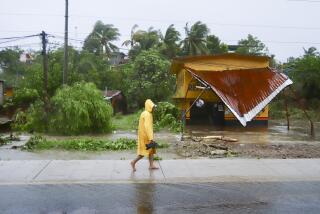Baja Resorts Rebound From Deluge : Mexico: Hotels clean up after last week’s downpour. But hundreds remain homeless, and roads are blocked.
CABO SAN LUCAS, Mexico — More than a week after a freak storm dumped almost two feet of rain on the Los Cabos resort zone of southern Baja, the all-important tourism industry appears to be on the rebound, as restaurants and shops finish cleaning up and new visitors arrive.
However, hundreds of area inhabitants remain homeless, major roads are blocked, water service is spotty and some areas still look like a disaster zone. Damage is estimated at $35 million.
Twenty-three inches of rain fell here during a 30-hour period on Nov. 3-4, more than three years’ worth of average precipitation in this parched region. A 15-inch rain 52 years ago is the only previously recorded storm that even approached the intensity of last week’s desert downpour.
“It was a little muddy here at first, but they cleaned it up real fast,” said John Powers, an engineer from Anchorage, Alaska, who was vacationing here when the storm hit.
“We lost everything,” declared a distraught Cecilia Aguire, 25, whose home was one of the more than 400 damaged at a government housing project that, authorities now acknowledge, was unwisely built in an arroyo.
She and others gathered on the roofs of their cinder-block homes as waves of water and mud cascaded down from the nearby Sierra de San Lazaro, uprooting trees, demolishing roads and burying scores of cars and trucks.
“I grabbed my children, climbed on the roof and prayed that the water wouldn’t reach us,” recalled Aurora Robles, a 31-year-old mother of four who also lost her home.
Among weary residents, rumors persist of unreported fatalities, buried in the mud--speculation repeatedly denied by government officials. Authorities say the area miraculously escaped deaths and serious injuries despite the intensity of the storm, which was by far the most severe on record here.
“These catastrophic rumors are simply untrue,” declared Baja California Sur’s governor, Guillermo Mercado Romero, who attended a forum on relief efforts Friday along with those coordinating the cleanup. “We invite visitors from everywhere to come here and see for themselves.”
Added Emilio Gamboa Patron, Mexico’s communication and transportation secretary, who toured the area by helicopter Friday, “This was an unexpected act of nature, but fortunately no lives were lost.”
In the past, Mexican authorities have often been accused of minimizing or concealing the impact of calamities, whether natural or man-made, including the 1985 Mexico City earthquake and the government’s violent repression of student demonstrations in 1968. Here, though, tourism officials have expressed alarm that exaggerated accounts of the destruction may scare off visitors.
The tourism industry, lifeblood of the isolated desert region about 900 miles south of San Diego, has picked up business in recent days. For a while, officials had considered whether to warn some would-be visitors to postpone their trips.
“We’re almost at 100% occupancy,” said Luis Coppola, whose family runs the Hotel Finisterra, situated almost directly at the tip of the Baja peninsula. “People have been calling, wondering if we’re open, whether we have electricity, water, whatever. But we’re back to normal.”
“Most of the approximately 30 hotels that serve the region are open and are near full during this prime game fishing season,” an industry official said.
Four hotels remained closed Friday with water and mud damage. The storm also washed away parts of two golf courses.
“From looking at things today, you wouldn’t know how much devastation there was,” said Kent Pearson, a doctor from Santa Rosa who arrived the day after the storm. “But they were filled with debris, bottles and sunken boats, and there was three feet of dirt and mud in the streets.”
On Friday, with a yachting regatta concluding, the harbor of Cabo looked calm beneath an almost cloudless sky. Debris still marred some of the area’s acclaimed beaches, though, and area streets remained muddy.
Meanwhile, workers were striving to repair the two damaged aqueducts that have left thousands of local residents without running water.
And--perhaps the most noticeable problem here--the principal highway connecting Cabo San Lucas with its international airport still suffers from major damage, including the destruction of two key bridges.
It will take three months to rebuild the highway, officials said. Traffic is now moving slowly, detoured off the road around the damaged stretches.
Some here have criticized construction methods used in the 25-mile highway that connects the airport to Cabo San Lucas. The $43-million roadway was inaugurated last summer by President Carlos Salinas de Gortari as part of his administration’s multibillion-dollar Solidarity anti-poverty program.
Authorities respond that the road was built to withstand the equivalent of the worst that previous storms had battered the peninsula with--but not last week’s unpredictable deluge.
More to Read
Sign up for Essential California
The most important California stories and recommendations in your inbox every morning.
You may occasionally receive promotional content from the Los Angeles Times.










